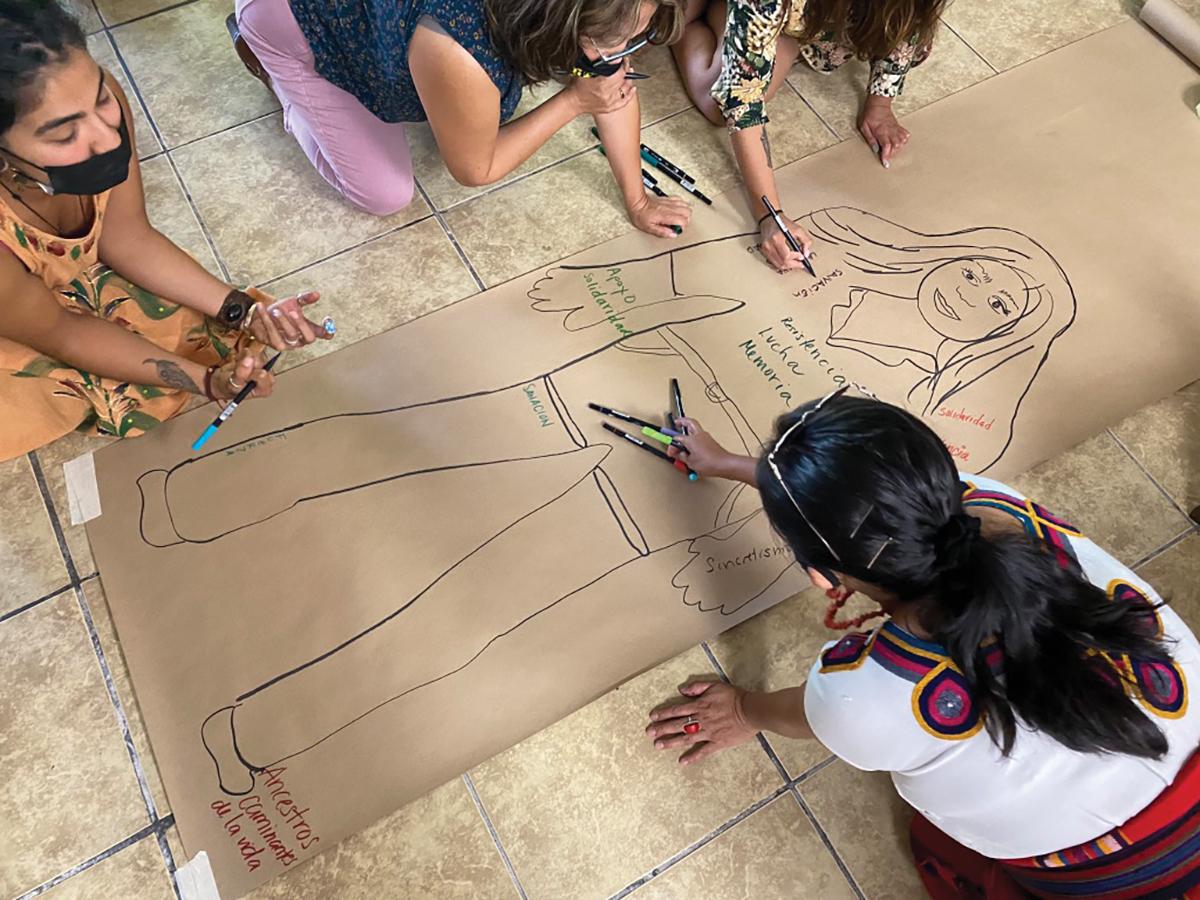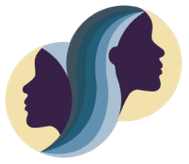
by Carla Macal, PhD Candidate, Department of Geography
My dissertation, entitled “Cuerpo-Territorio: Cultural Memory, Intergenerational Trauma, and Cartographies of Healing among GuateMaya Feminist Groups,” aims to analyze feminist groups organized by Guatemalan women across the hemisphere in response to state gender violence particularly in Guatemala. Femicides registered in Guatemala increased 31 percent between January and August 2021, compared to the same period the previous year, according to a report released by the humanitarian entity Grupo de Apoyo Mutuo (GAM). The groups participating in my dissertation work are involved in building a permanent memory of current state violence against women and girls, but also weaving in the memory of those the 36-year war (1960–1996) disappeared, murdered, and tortured in Guatemala. Records indicate that 200,000 (83%) of the Maya population was killed, 45,000 people disappeared, and 1.5 million displaced (Manz 2008). Beyond settler-colonial borders, feminist groups composed of Maya, Ladina,1 and migrant women working intergenerationally continue to endure emotional trauma from the war years but are motivated to break the silence of the war through a transformative memory. My dissertation aims to contribute to Indigenous decolonial feminist epistemology of cuerpo-territorio by looking at the lived experiences of Guatemalan women survivors of the 36-year war and the intergenerational trauma and healing actions feminist groups are using in their dialogs and activities.
With a graduate research grant from the Center for the Study of Women in Society (CSWS), I was able to conduct ethnographic fieldwork in Los Angeles during the summer of 2021. I am resorting to the popular method of body-mapping to delve into my research question: How, specifically, is transformative memory inscribed in the body, in public space, and in other symbolic and material geographies that the groups move in? The GuateMaya feminist group I am working with in Los Angeles is GuateMaya Mujeres en Resistencia-LA (GMR-LA). GMR-LA is forming group identity and making meaning and place to honor family members and compañeros taken by the war. They are engaging in counter-hegemonic production of cultural memory by organizing protests, vigils, and art to share the truth of the genocide and to continue the legacy of leftist groups in Guatemala. Ester Hernandez’s (2017) work on mapping Central Americans in Los Angeles’ public spaces and memory states, “Migrants become embedded in a larger struggle for justice; they create community and provide a historical context for the following generations. This allows for the creation of spatial imaginaries on the urban cityscape of Los Angeles” (145). I am interested in how the physical bodies of women war survivors of Guatemala store memory and trauma and how through body-mapping platicas (dialogs) we can begin to speak about the past and move forward to heal.
As a first-generation community scholar that shares similar intergenerational trauma with research participants, I will also share my personal statement of ethics with participants and explain that we can stop the interview process whenever it becomes uncomfortable or overwhelming. Some of my family members are also survivors of the war in Guatemala. Some are political refugees and choose not to speak about it due to the pain it causes. For years I’ve been working on my own emotional distress from the war. I also see my dissertation as a space for personal healing and growth. Shanon Speed (2021) discusses the distance between activism and collaborative work in academia and urges victims to reflect and write about our embodied emotions encountered in the field. The relationships I have built with GMR-LA and in my community are strong, and I aim to connect with my research work through my own emotions as well.
I use body mapping as a tool to support participants sharing about emotions, place, and trauma. Latin American feminist decolonial geographers (Cabnal 2010; Zaragocin 2020; GeoBrujas 2021) are using the method of body mapping as a decolonial, counter-cartographic perspective that highlights Indigenous peoples’ lived experiences. In addition to body mapping, the method of testimonio will provide space for Maya women living in Los Angeles to share their perspectives of migration, trauma, and relationships.
Body mapping has been generally defined as, “The process of creating body-maps using drawing, painting, or other art-based techniques to visually represent aspects of people’s lives, their bodies and the world they live in” (Gastaldo et al., 2012, 5). Since the 1980s, body mapping has been used by medical doctors and with HIV positive people to raise awareness and self-esteem, and to document migration experiences and health concerns of undocumented workers. For this method, I am borrowing from the methodological guide mapeando el cuerpo-territorio, guia metodologica para mujeres que defienden sus territorios (mapping body-territory, methodological guide for women who defend their territories) created by Ecuadorian colectivo miradas criticas del territorio desde el feminism (Cruz et al., 2017). The guide provides different tools and step-by-step instructions on how to facilitate body-mapping workshops with Indigenous women.
On October 3, 2021, I facilitated my first body-mapping workshop with five participants of GMR-LA. Using the guide and the following questions to map our emotions on our bodies, I asked each participant: 1. Can you draw where in your body you have experienced any type of violence in Guatemala or in Los Angeles? And how did it feel? 2. Can you draw how the fear of violence has impacted your body? 3. Can you draw what emotions you feel when you walk in Los Angeles as a Maya woman? 4. How has the process of migration impacted your body? 5. Can you draw in your body how power and strength feel?
The participants had an hour to complete their drawings, and at the end we gathered in a circle to share our embodied testimonios. Everyone really focused more on the present moment, how they see themselves, the places they actively frequent, and their feelings toward those places. Two of them shared how they felt about Immigration Custom Enforcement (ICE) and detention centers and how these places and institutions inflict fear, anger, and sadness on them and communities. The group also drew a body of a woman representing the group. They wrote words on the body that reflected the groups work like intergenerational, solidarity, unity, and ancestral knowledge (to name a few). They were all very excited to see their work reflected in words and in a collective body.
Overall, the body mapping workshop became a space for the group to retreat from their daily routines and focus on themselves. One of the participants shared how this type of work is necessary for survivors of war and can allow for honest conversations about the past to move into healing, restoration, and trust. I am excited for this work and I am currently organizing a second body mapping workshop with groups I am working with in Guatemala this summer 2022.
—Carla Macal received a 2021–22 Graduate Student Research Grant from CSWS.
Notes
1 Ladina refers to a woman who is mixed from Indigenous and European hybridization. Scholars identify ladino and ladina as a place in between the elite Spanish-speaking state and the Indigenous communities (Harms 2020).
References
Cabnal, L. (2010). Acercamiento a la Construccion de la Propuesta de Pensamiento Epistemico de las Mujeres Indigenas Feministas Comunitarias de Abya Yala. Feminismos Diversos: El Feminismo Comunitario. 1–33.
Cruz, T. et al. (2017). Mapeando el cuerpo territorio. Guia metodologica para mujeres que defienden sus territorios. Miseror.
Gastaldo, Denise; Magalhães, Lilian; Carrasco, Christine & Davy, Charity (2012). Body-map storytelling as research: Methodological considerations for telling the stories of undocumented workers through body mapping. Retrieved from: http://www.migrationhealth.ca/undocumented-workers-ontario/body-mapping.
GeoBrujas (2021). Counter-cartographic perspectives. American Association of Geographers April 10, 2021 Zoom presentation.
Hernandez, E. (2017). Remembering through cultural interventions. Mapping Central Americans in L.A. Public Spaces. In U.S. Central Americans: Reconstructing memories, struggles, and communities of resistance. Ed. By Karina O. Alvarado, Alicia Ivonne Estrada, and Ester E. Hernandez. The University of Arizona Press, 144–165.
Speed, S. (2021). Grief and Indigenous Feminist’s Rage: The embodied field of knowledge production. In Indigenous Women and Violence: feminist activist research in heightened states of injustice. Ed by Lynn Stephen and Shannon Speed. The University of Arizona Press, 26–42.
Zaragocin, S. and Caretta, M. (2020). Cuerpo-Territorio: A decolonial feminist geographical method for the study of embodiment. Annals of the American Association of Geographers, 0(0), 1–16.

